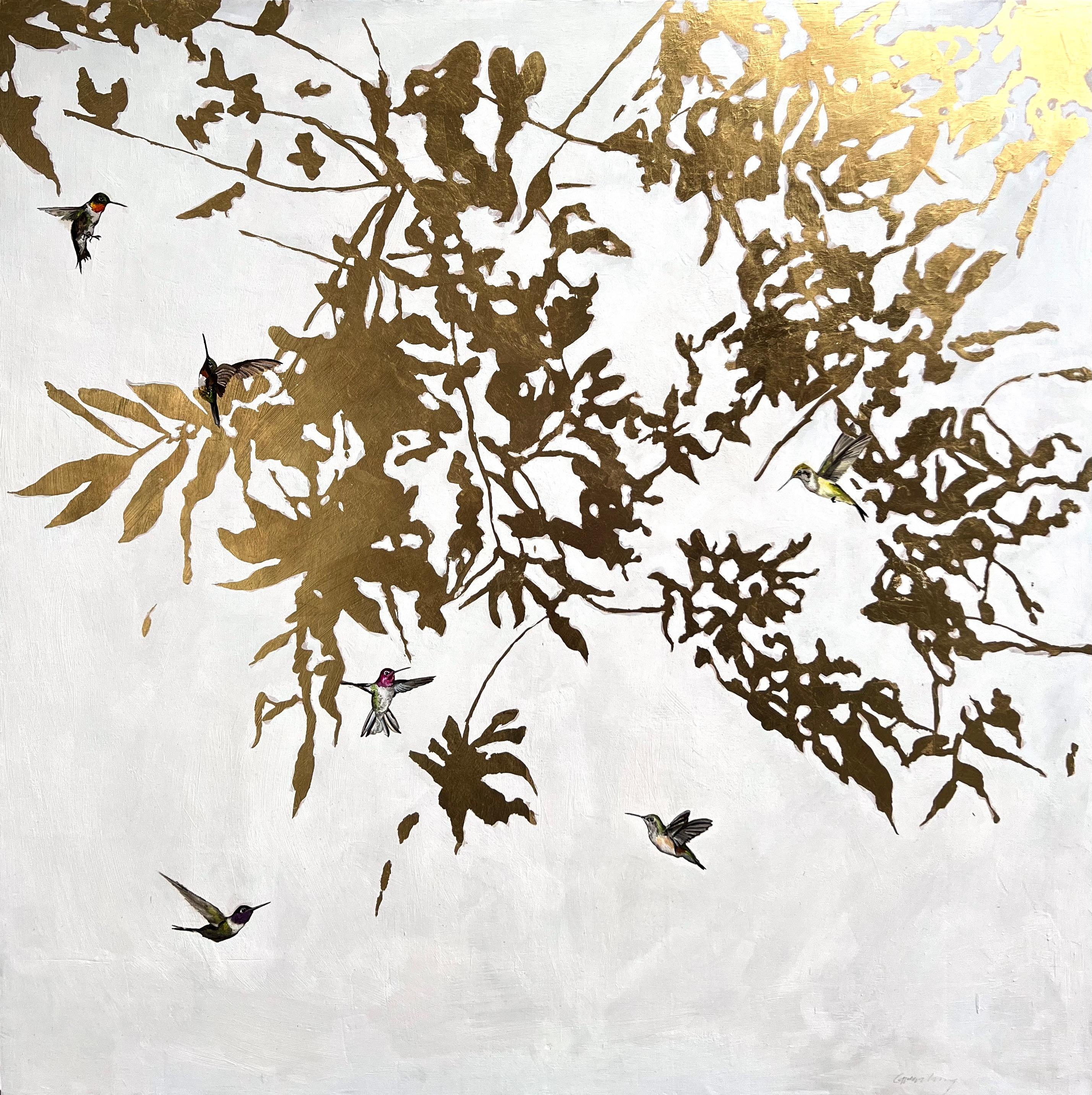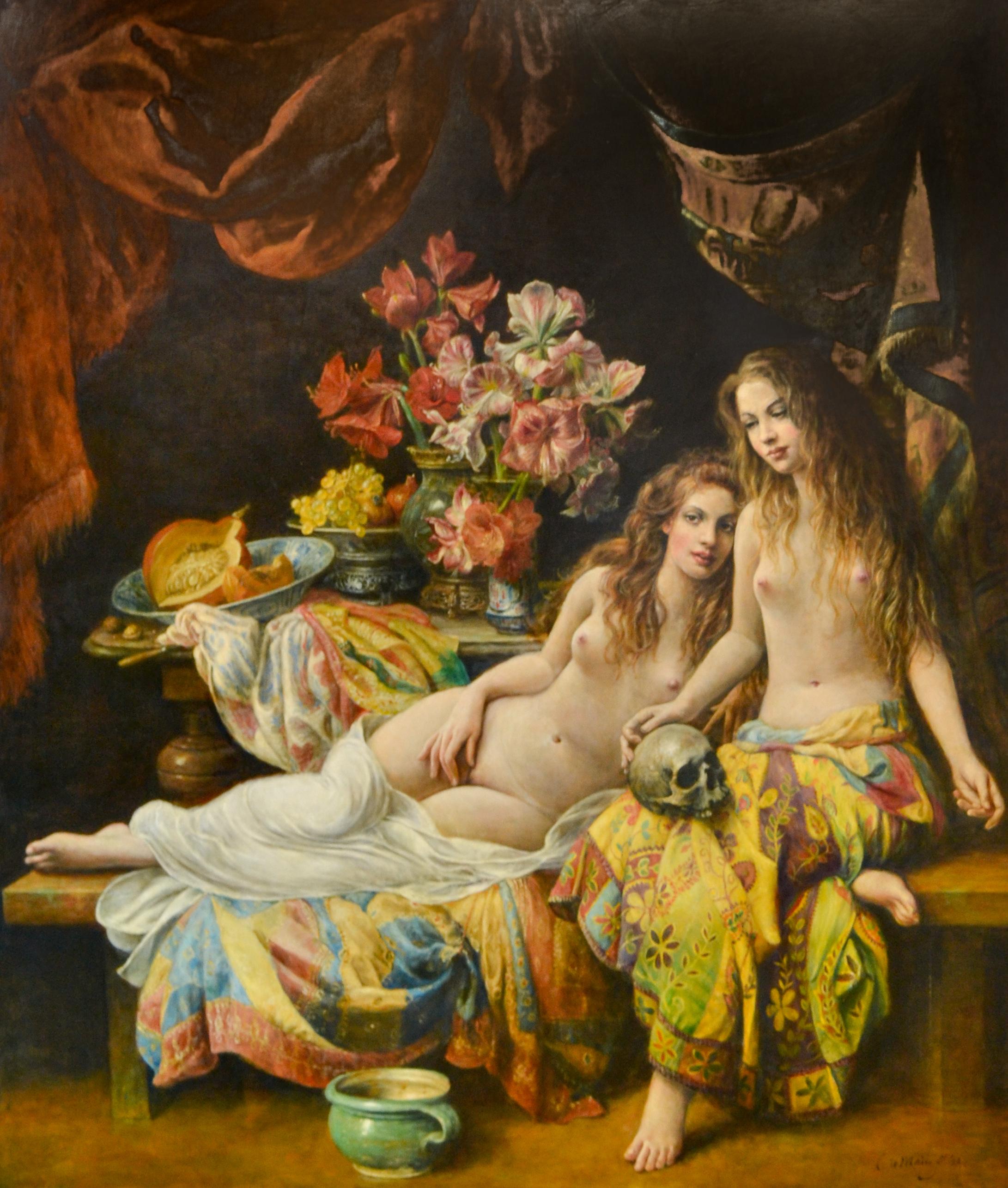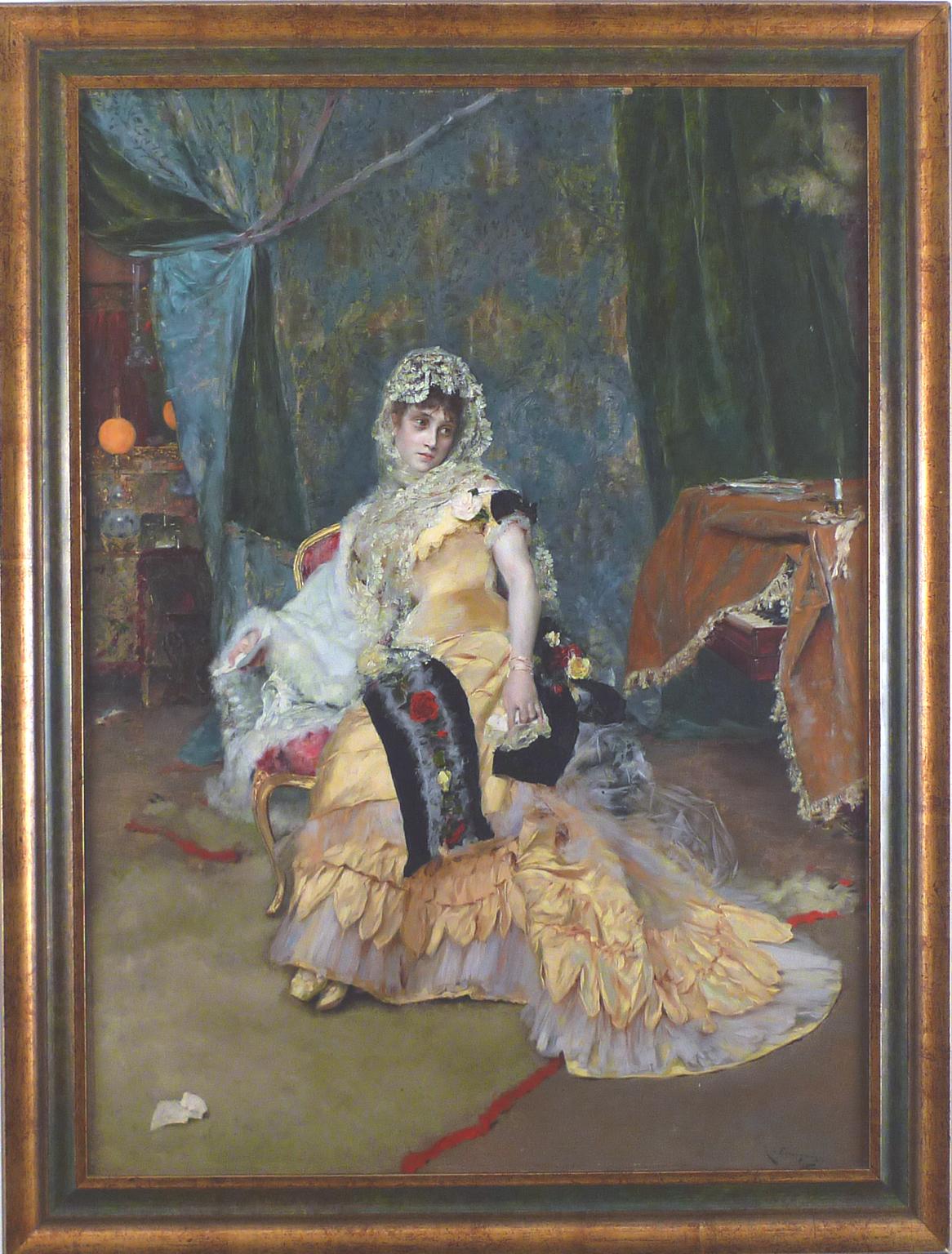Items Similar to The Annunciation, Gilt Easel Oil Painting, 19th Century European School
Want more images or videos?
Request additional images or videos from the seller
1 of 2
UnknownThe Annunciation, Gilt Easel Oil Painting, 19th Century European School
About the Item
Oil on panel
Crescent image size, including frame: 11 x 7 3/4 inches (28 x 19.5 cm)
Original gilt easel frame
This crescent oil piece beautifully depicts the scene of the Annunciation, also referred to as the Annunciation to the Blessed Virgin Mary, the Christian celebration of the announcement by the angel Gabriel to Mary that she would conceive and bear a son through a virgin birth and become the mother of Jesus Christ. Here we see the angel Gabriel on the left in a reassuring posture of prayer with the Virgin Mary sat on the right in a state of amazement. The two figures perfectly fill the edges of this crescent space, conveying to the viewer the enormity of this interaction, while the sustained space between them illustrates Mary's initial confusion and weariness.
The annunciation has been one of the most frequent subjects of Christian art. Depictions of the Annunciation go back to early Christianity and has been a favourite subject in both the Christian East and as Roman Catholic Marion art.
The motif of the vase became commonly used in the depiction of the scene, a tradition that became linked with the inclusion of the lily. Sometimes the lily is in the vase as part of a general setting or, as is the case here, the lily is held by Gabriel acting as a symbol of the Virgin's purity.
The posture of Mary is a detail that many artists took great care to depict because of the opportunity it gives to explore Mary's psychological reaction to the presence of Gabriel. Italian preachers, such as the famous Fra Roberto Caracciolo of Lecce, made detailed analyses of the account given by St Luke, going as far as to lay out a series of five spiritual and mental conditions that Mary went through when encountering Gabriel's message. According to Fra Roberto, these were said to be, in order - Disquiet, Reflection, Inquiry, Submission and Merit. In this instance it has been interpreted with the first of her reactions - disquiet and an expression of alarm at the appearance of the angel.
- Dimensions:Height: 11 in (27.94 cm)Width: 7.75 in (19.69 cm)
- More Editions & Sizes:1 of 1Price: $2,236
- Medium:
- Period:
- Condition:
- Gallery Location:London, GB
- Reference Number:1stDibs: LU52412858312
About the Seller
5.0
Vetted Seller
These experienced sellers undergo a comprehensive evaluation by our team of in-house experts.
Established in 2007
1stDibs seller since 2014
64 sales on 1stDibs
Typical response time: 2 hours
- ShippingRetrieving quote...Ships From: London, United Kingdom
- Return PolicyA return for this item may be initiated within 14 days of delivery.
More From This SellerView All
- Saint Sebastian, 15th Century Religious Oil Painting on PanelLocated in London, GBOil on panel Image size: 16 x 13 1/4 inches (41 x 34 cm) Early gilt frame Saint Sebastian was a Roman centurion who converted to Christianity and, in punishment, the Roman Emperor D...Category
15th Century and Earlier Italian School Figurative Paintings
MaterialsOil, Panel
- The Traveller, European School Oil Painting on panel, Original FrameLocated in London, GBOil on panel Image size: 12 1/2 x 9 1/4 inches (31.75 x 23.5 cm) Original frame This is a captivating portrait of a young woman who we appears to be a traveller. The painting has a ...Category
19th Century Figurative Paintings
MaterialsOil, Wood Panel
- Study for Eastward Ho!, Oil on Panel 19th Century PaintingLocated in London, GBOil on panel Image size: 20 x 16 inches (51 x 40.5 cm) Handmade gilt frame Provenance Family estate This preliminary oil sketch for one of O'Neil's most famous works, "Eastward Ho!...Category
19th Century Victorian Figurative Paintings
MaterialsPanel, Oil
- A decorative oval relief with Venus and Cupid, 18th Century Rococo OilBy Jacob De WitLocated in London, GBFollower of Jacob de Wit 1695-1754 Venus and Cupid Oil on panel Image size: 7 ¾ inches x 11 ¾ inches Gilt frame A charming example of trompe-l'œil, this painting is abrim with...Category
18th Century Rococo Figurative Paintings
MaterialsOil, Panel
- William, 1st Viscount Bateman and FamilyLocated in London, GBOil on canvas Image size: 24 x 18 1/2 inches (61 x 47 cm) Gilded wood framed Provenance Estate of Judge Davis Norton and Florence Edelstein. William Bateman was a British Whig politician who sat in the House of Commons between 1721 and 1734. He was made Knight Companion of the Order of the Bath...Category
Early 18th Century Figurative Paintings
MaterialsOil, Canvas
- Ophelia, Victorian 19th Century Royal Academy Oil PaintingLocated in London, GBOil on canvas, signed lower right Image size: 33 1/2 x 56 1/2 inches (85 x 143 cm) Original gilt frame Provenance With the artist's son, Millie Dow Stott Esq., until 1912. Artist's Studio Sale, Christies, November 1913. Private Collection Exhibitions London, Royal Academy, 1895, no. 679. Paris, Societe de la Nationale des Beaux-Arts, 1896, no. 1179. Berlin, VII Internationale Kunstausstellung 1897. no. 3533. Manchester, City of Manchester Art Gallery, 1912, no. 339. In the 1890s William Stott exhibited regularly at the Royal Academy, mainly highly decorative works with subjects derived from classical mythology and literature. This painting was Stott's 1895 entry to the Royal Academy and was subsequently exhibited at the Paris Salon of 1896 and then on to the Berlin, VII Internationale Kunstausstellung 1897. Shakespeare was a favourite source for Victorian painters, and the tragic romance of Ophelia, from Hamlet, was an especially popular subject, featuring regularly in the Royal Academy exhibitions. The most popular and iconic image of Ophelia's death was, and is to this day, John Everett Millais's 1851 painting showing the confused and tragic Ophelia floating downstream on her back in a state of mad ecstasy, arms raised in a gesture of inevitable submission. However, although Stott chose not to pastiche this image, it seems highly likely that he was prompted to take up this subject, which had almost become a 'rite of passage' among Victorian painters, by the fact that in 1894 Millais's Ophelia was presented to the National Gallery of British Art by Sir Henry Tate. It appears that Stott was much influenced by John William Waterhouse...Category
Late 19th Century Victorian Figurative Paintings
MaterialsOil, Canvas
You May Also Like
- Come TogetherLocated in Atlanta, GAGwen Wong's work is both painterly and allegorical, caught somewhere in the middle between the representational painter and the narrator. "I am inspired by t...Category
2010s Contemporary Figurative Paintings
MaterialsGold Leaf
- Hercules and Omphale, Old Master Painting, Mannerism, Baroque, Mythology, PragueLocated in Greven, DEHercules and Omphale Oil on panel, 52 x 41 cm According to legend, Hercules had to make atonement and became a slave to the Lydian queen Omphale. When she found out who her slave was, she married him. Falling for his mistress and made effeminate by the luxury of court life, the former hero allowed himself to become the laughing stock of the court. He dressed in women's clothes, spun wool and did other women's work, whereas Omphale wore his lion's skin and carried a wooden club. When the time of punishment was over, the hero realised his delusion and left Omphale. So far, the painting could not be clearly assigned to an artist. Nevertheless, it impresses with its fluid and convincing painting, whose colourfulness and conception are reminiscent of the Prague School around Bartholomäus Spranger. This work follows an engraving and an etching made by Michel Dorigny in 1643 after a design by Simon Vouet. It shows the same scene but the print differs in minor details from the present painting (see e.g. the head of the lion) and the treatment of the faces seems to be painted more detailed and refined. So far there is no painting...Category
17th Century Baroque Figurative Paintings
MaterialsOil, Panel
- Still-Life with Red-White Canvas - 21st Century Contemporary Oil PaintingBy Henk HelmantelLocated in Nuenen, Noord BrabantHenk Helmantel probably does not need an introduction to a lot of worldwide art lovers. After all, the artist from Westeremden even has its own museum. ...Category
2010s Contemporary Interior Paintings
MaterialsWood Panel, Oil
- Two nude woman sitting on their sofa- 21st Century Contemporary Oil PaintingBy Cornelis Le MairLocated in Nuenen, Noord BrabantCornelis le Mair (Eindhoven, July 3rd 1944) is a Dutch painter. This Romantic painter is famous because of his 17th century paintings. As a child, Le Mair already developed a talen...Category
2010s Contemporary Nude Paintings
MaterialsWood Panel, Oil
- "Lady in yellow", 19th Century oil on panel by Rogelio de Egusquiza y BarrenaBy Rogelio de Egusquiza y BarrenaLocated in Madrid, ESROGELIO DE EGUSQUIZA Y BARRENA LADY IN YELLOW signed "R. Egusquiza" (lower right) oil on panel 28-5/8 X 20-3/4 inches (72.5 X 52.7 cm.) framed: 32-5/8 X 24-3/4 inches (82.5 X 62.5 cm.) Rogelio de Egusquiza y Barrena (1845 – 10 February 1915) was a Spanish painter, known for his friendship with the German composer Richard Wagner, whose works he helped make familiar in Spain He was born in El Astillero, into a well-to-do family. He studied in Madrid and with Léon Bonnat at the École des Beaux-Arts in Paris. In 1868, after travelling and participating several times in the National Exhibition of Fine Arts, he returned to Paris and settled there. At first, he painted historical scenes, but later turned to genre scenes and portraits in the Academic style. Following the death of Marià Fortuny, he moved to Rome at the invitation of the Madrazos, Raimundo and Ricardo, taking Fortuny's place at their studio through 1875 and attending classes at the Spanish Academy in Rome. He heard Wagner's music for the first time in 1876, after returning to Paris. Three years later, he travelled to Munich to hear a performance of The Ring of the Nibelungen. His enthusiasm for what he heard led him to go to Bayreuth, where he introduced himself to Wagner and became his friend. In the following years, he and Wagner got together again several times; in Venice (1880), Berlín (1881) and Bayreuth (1882); where he was a guest at the premiere of Parsifal. After his first meeting with Wagner, he decided to devote his career to doing works on Wagnerian themes; mostly portraits of the characters rather than specific scenes. During his visits to Germany, he also created portraits of Arthur Schopenhauer (posthumous) and King Ludwig II...Category
1880s Realist Interior Paintings
MaterialsOil, Panel
- Blowing BubblesBy Théophile Emmanuel DuvergerLocated in Belgravia, London, LondonOil on panel Panel size: 21.5 x 17.25 inches Signed??Category
19th Century Figurative Paintings
MaterialsOil, Panel




